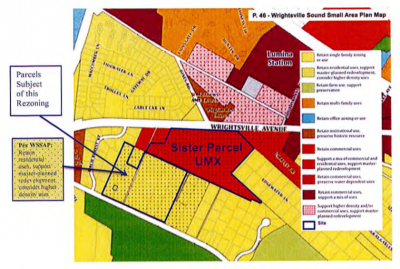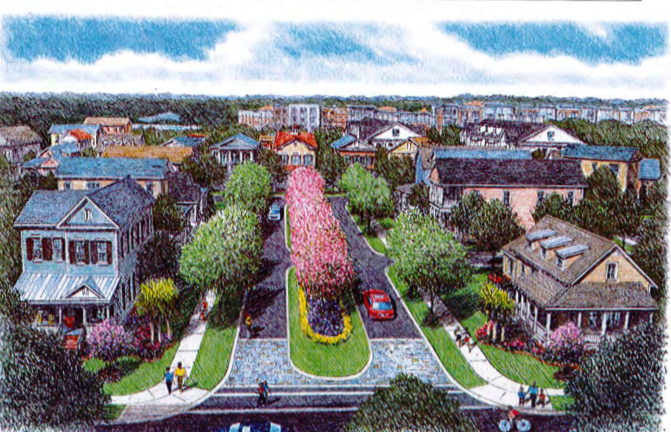
WILMINGTON – Airlie Road is only a mile and a half long, but it holds a prominent place in Wilmington’s history – and in the minds of many of the locals. The two-lane roads shows a distinct slice of southeastern North Carolina as it winds through moss-covered live oaks and past stately homes, until it reaches the salt marsh where it turns and runs parallel to the waterway.
For those who’ve driven down the road a time or 20, it’s no surprise that it was designated by the North Carolina Board of Transportation as a scenic byway in 2013. But in recent months, development pressure on the area has increased. Area residents say a rezoning request from Dockside Restaurant for improvements to a parking lot along Airlie Road and another request for a proposed housing community adjacent to the Galleria Shopping Center could dramatically change the character of the area.
Supporter Spotlight
Earlier this month, the Wilmington Planning Commission approved the Dockside proposal and that measure is expected to go before the city council during its meeting at 6:30 p.m. Feb. 7. Meanwhile, the city planning commission is set to hold a public hearing at 6 p.m. Wednesday on the housing development plan known as Airlie at Wrightsville Sound and listed on the meeting agenda as “315 Airlie Road.”
More than 50 area residents overflowed a meeting room last week to hear more details about the housing project. The developers, including Charlotte-based State Street Companies Inc. and LandDesign, tried to assuage residents’ worries. It was a tense meeting, with visible frustration on both sides, as each offered opposing views of the best path forward for Airlie Road.
“There is a lot at stake, not only the beauty of the area but what impact (the proposed development) may have on the environment,” said Mike Giles, coastal advocate with the North Carolina Coastal Federation.
Supporter Spotlight
A Special Place
Much of the acreage along what’s now Airlie Road was deeded to the Ogden brothers in a 1736 land grant. This was before Joshua Grainger Wright, from whom Wrightsville Beach takes its name, became the owner. Sarah Jones, a Wright relative and wife of wealthy industrialist Pembroke Jones, is credited with beginning to landscape and develop the current Airlie Gardens, which is across the street from the proposed development. The Jones family sold much of the land to the Corbett Package Co. in the 1940s. And the Corbett family often opened it to the public and eventually sold 67 acres to New Hanover County for the gardens, which feature freshwater lakes, trails along Bradley Creek and the 500-year-old Airlie Oak.

“Airlie Gardens and the surrounding area are very special, not only to people living on Airlie Road, but to New Hanover County residents,” said Paula Corbett. Her husband Albert remembers playing along Bradley Creek as a child and the couple now have a home on the waterway. “This historic road is a treasured piece of rich history and culture, and must be maintained for generations to come.”
Paula and Albert Corbett were among those who attended the community meeting last week, and spoke with the developers about the proposal.
Most of those at the meeting agreed that Airlie Road will change as more people want to live near Wrightsville Beach. Many residents mentioned keeping the current, low- to medium-density residential zoning to maintain the current pattern and pastoral feel of the neighborhood of large home sites and yards. With few specific exceptions, commercial uses are prohibited in the existing R-15 district.
‘In Line with Wilmington’s Plan’
Representatives of the project have touted the benefits of their modern, more urban design that has a Southern-streetscape aesthetic, like parts of Charleston, South Carolina.
“It’s is in line with Wilmington’s development plan,” said Jeff Kentner, with State Street.

An earlier version of their plans for the 11.9-acre parcel included a mix of single-family homes and townhomes. The company’s current plan has only 57 single-family lots but still requests a zoning change to UMX, or conditional urban mixed-use development, which is how the adjacent “sister parcel,” the 7.5-acre former Galleria shopping center site that fronts Wrightsville Avenue is currently zoned.
UMX zoning would allow for higher density and the developers’ proposal offers street access to both Airlie Road and Wrightsville Avenue.
The developers’ presentation included details about saving 27 of what they called “heritage trees” on the property and plans for several small parks. They’ll also preserve existing canopy trees and flowering trees and plant new ones, said Richard Petersheim, a landscape architect with LandDesign.
Kentner also said that the Galleria site would include three restaurants, a fitness center, a grocery and a luxury hotel.
“I think the changes they’ve made show a willingness to compromise,” Giles said.
Despite the changes, Giles said additional new houses and businesses will likely have an adverse effect on the quality of nearby waterways. The federation has long worked with officials in Wrightsville Beach, Wilmington, the North Carolina Department of Transportation, and UNC Wilmington to reduce the volume of stormwater runoff flowing into Bradley and Hewletts creeks, in efforts to reduce the amount of contaminants entering the waterways.
“This is work we’ve been doing for years, really, to mitigate the impact of polluted stormwater,” Giles said.

Also discussed during the meeting were the effects the development could have on traffic in the area. Paula Corbett said some of the traffic numbers used may be outdated. Her company, Eastcoast Research, conducted a four-hour, peak-time traffic count on Dec. 22, 2016, and determined that 2,108 cars either turned onto Airlie Road or traveled from Airlie to Oleander Drive and Military Cutoff during the period.
“This small sample does not qualify as significant data,” Corbett said, “but does serve the purpose of showing the significant number of cars which enter and exit Airlie Road.”
Although Corbett likes many of the aspects of the community proposal, one of the things she’d like to see going forward is a comprehensive traffic-flow study. Corbett also prefers a wider, 50-foot setback from the road to maintain the scenic integrity of Airlie Road, she said.
During the meeting, Kentner said the cars from the Airlie Road development would ultimately not add to congestion in the area because residents would be able to walk, rather than drive, to many retail destinations. Kentner and other development representatives at the meeting expressed some willingness to make other compromises, including increasing the buffer between the community and the street.
Although several at the meeting suggested postponing the discussion, the developers said they were planning to keep their appointment Wednesday with the planning commission.








